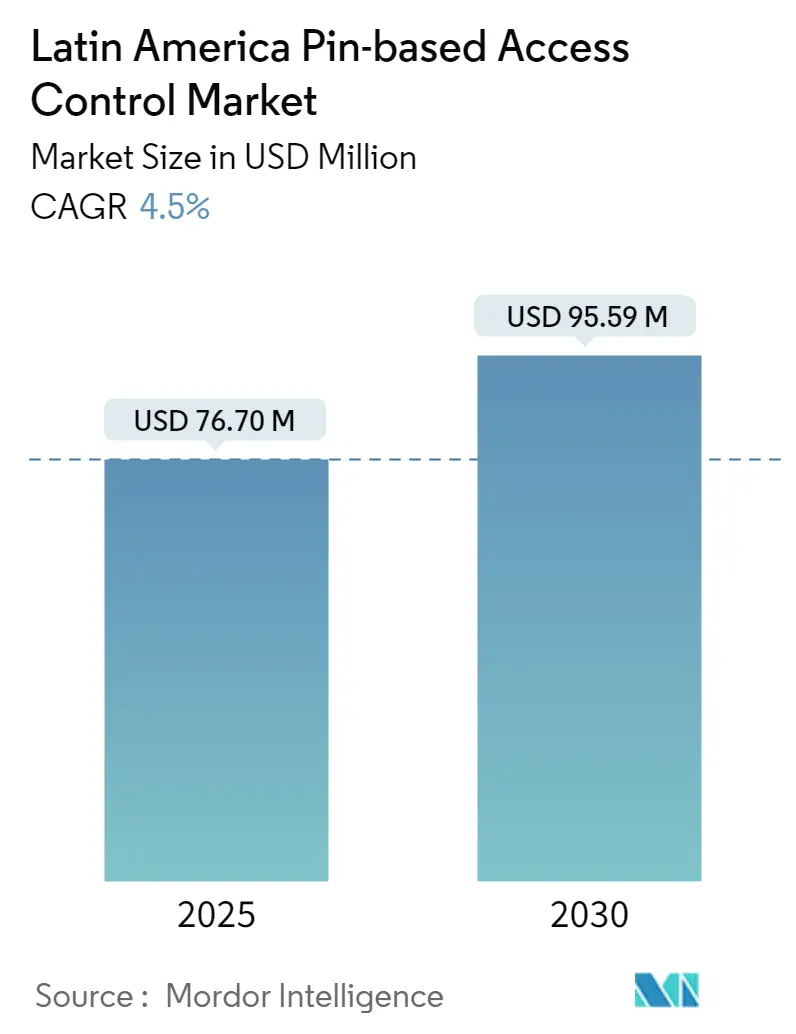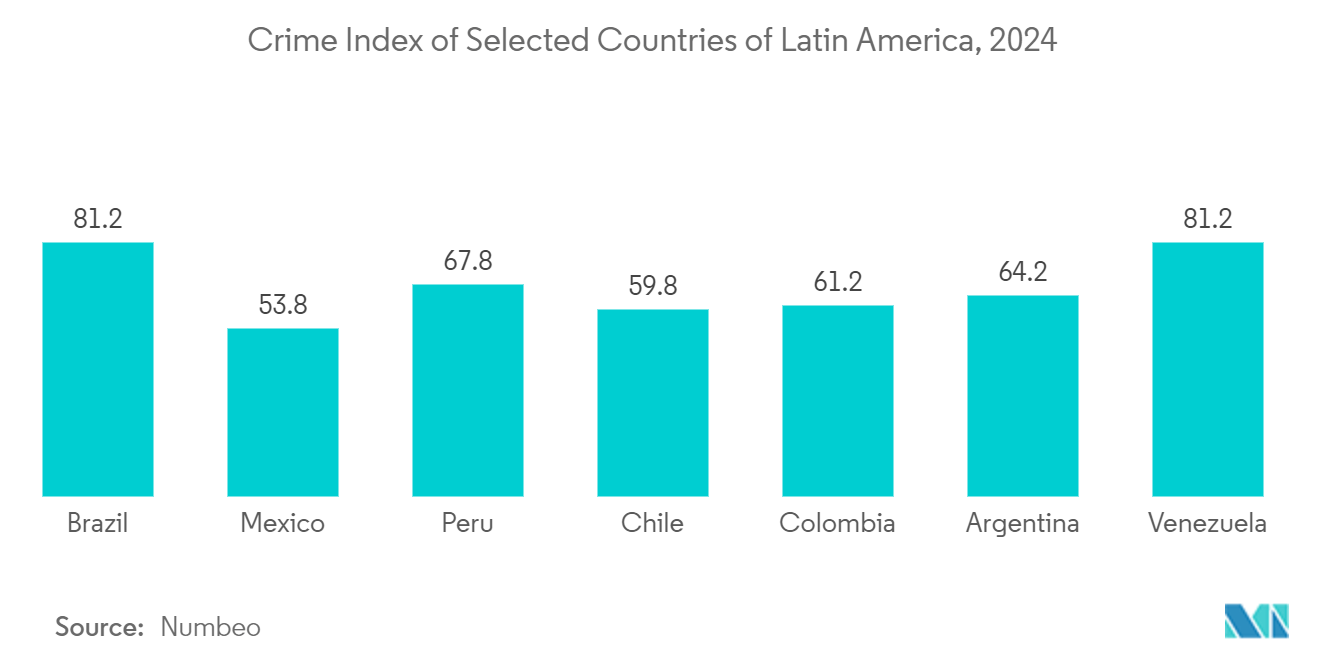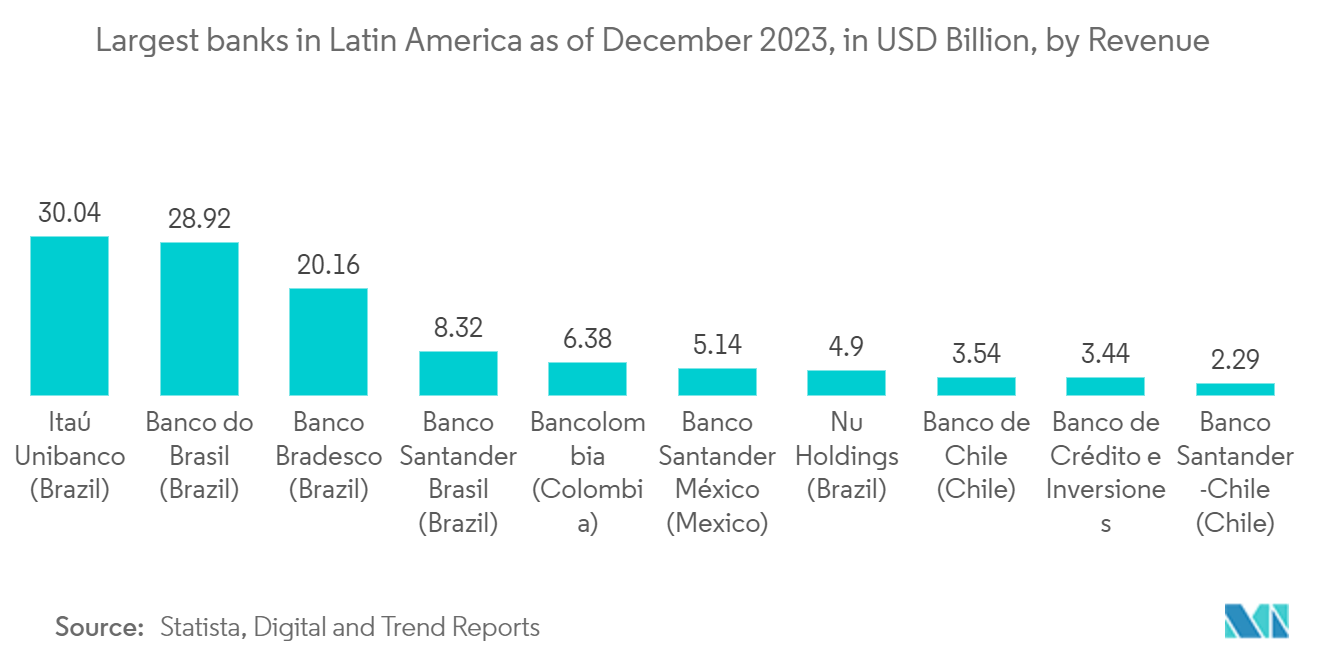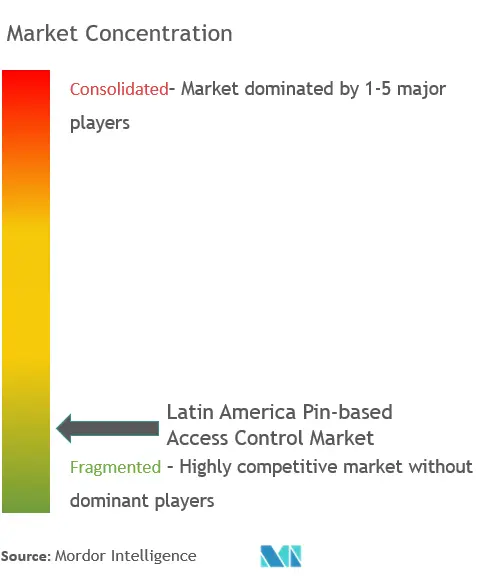Latin America Pin-based Access Control Market Size and Share

Latin America Pin-based Access Control Market Analysis by Mordor Intelligence
The Latin America Pin-based Access Control Market size is estimated at USD 76.70 million in 2025, and is expected to reach USD 95.59 million by 2030, at a CAGR of 4.5% during the forecast period (2025-2030).
- Rising concerns over privacy and security, coupled with a surge in data theft, are key drivers propelling market growth. In recent years, Latin America has witnessed a surge in thefts and crime rates, raising significant concerns about the safety of individuals, assets, and operations. These trends have not only led to substantial infrastructure damage but also tragically claimed numerous lives. Access control systems play a significant role in modern security measures. These systems bolster property security and streamline entry for authorized personnel while effectively blocking unauthorized access.
- Furthermore, pin-based access controls are easily scalable, which makes them suitable for SMEs who want to secure their data without having to spend extra money. Several organizations are upgrading to pin-based attendance systems to minimize the efforts, as the traditional method of keeping track of time and attendance resulted in expensive mistakes and aggravating inefficiencies because employees had to fill out paper timesheets to track their working hours.
- In 2023, as reported by Brazil's Ministry of Defense, Sao Paulo, the city in Brazil witnessed over half a million theft cases, excluding vehicle theft, marking it as the most prevalent crime. Following closely, robberies accounted for nearly 222,000 incidents, making it the second most common offense. Moreover, as per the 2023 Brazilian Public Security Yearbook, certain states in Brazil exhibit elevated rates of vehicle robbery and theft. Rio de Janeiro, reporting 562 incidents per 100,000 vehicles in 2022, is topping this list. Following closely is Pernambuco, situated in the Northeast, with 534 cases per 100,000 vehicles. Such activities create a huge demand for access control solutions.
- Despite a projected contraction in 2025, the Mexican construction industry is set to rebound. This dip is largely attributed to high base effects and the culmination of significant infrastructure projects. In a proactive move, in November 2023, the Mexican government issued a decree focused on bolstering the nation's rail infrastructure. Simultaneously, they rolled out a recovery initiative, allocating a substantial MXN 69.9 billion (USD 3.4 billion) for revitalizing key infrastructure in Acapulco. Furthermore, as part of the 2024 Federal Budget Proposal, the government earmarked a net spending of MXN 9.1 trillion (USD 441.1 billion), marking a 4.3% increase from the 2023 budget. The increasing construction across the countries will propel the market growth in the coming years.
- Additionally, biometrics authentication is rapidly increasing across various industries by providing more secure identity verification processes. This technology uses physical characteristics like facial recognition, fingerprint scan, voice recognition, and retina recognition to authenticate the user. The necessity for strict identity verification due to the accelerating adoption of transactional technologies is increasing the demand for biometrics access controls, which consumers prefer over traditional pin-based access control, hindering market growth.
- The growing inflation rates have increased the cost of goods and services, including access control systems. Higher costs lead to reduced purchasing power for consumers and businesses, slowing market growth. Further, the ongoing war between Russia and Ukraine has disrupted the global supply chain, particularly affecting the availability and cost of electronic components and raw materials used in access control systems. This is leading to delays in production and increased costs for manufacturers.
Latin America Pin-based Access Control Market Trends and Insights
Large Enterprises Segment to Hold Significant Market Share
- Organizations are ensuring the necessary safety controlling processes. The well-organized and controlled access to company sites, offices, and facilities provides security and enhances trust in staff, customers, and suppliers. The market for pin-based access control systems is expected to grow due to increasing safety consciousness, the growing demand for high-level access control systems, and the adoption of access control devices in commercial organizations.
- As commercial door lock systems with keypads provide enhanced security, eliminating the need for physical access keys, several property owners and senior management professionals alternate the PIN code from time to time to ensure that only authorized personnel can access the space.
- The increasing number of smartphone sales in the region is expected to increase the demand for pin-based access control with the integration of mobile applications. The sales of smartphones were 28 million units in Q1 2023. Such systems provide building and office managers with a cost-effective solution for managing identification credentials.
- Access control systems have become the preferred way to manage access to large enterprises, offices, and businesses due to the increasing number of robbery or burglary incidents in Brazil, Argentina, and Mexico. The market for access control systems is expected to grow due to increasing safety consciousness, the growing demand for high-level access control systems, and the adoption of access control devices in commercial organizations.

Brazils Hold Significant Market Share
- Urbanization in the country is driving the need for access controls in residential and commercial areas owing to security concerns. Technological advancements and digitalization drive the demand for solutions across organizations. Furthermore, the cumulative adoption of smartphones and mobile computing devices will drive the adoption of the pin-based access control market across the country.
- As the popularity of physical and cyber security systems continues to increase, several industries are implementing multi-factor authentication policies to reduce severe security breaches. According to Avilgilon's research, multi-factor authentication can prevent up to 90% of attacks that compromise property access passwords.
- Brazil has the largest number of banks in Latin America; financial institutions are using sophisticated technology and monitoring techniques to ensure user safety while offering the convenience of online banking. With increasing thefts, banks have integrated multi-factor authentication, such as PINs or passwords, and biometric authentication. The country's substantial increase in data breaches is increasing, and pin-based access provides users with another layer of security to secure themselves.

Competitive Landscape
The Latin America pin-based access control market is fragmented and has several players. Companies in the market continuously try to increase their market presence by introducing new products, expanding their operations, or entering into strategic mergers and acquisitions, partnerships, and collaborations. A few prominent players include Johnson Controls, HID Global Corporation, Hangzhou Hikvision Digital Technology Co. Ltd, Honeywell International Inc., Thales Group, and many more.
Latin America Pin-based Access Control Industry Leaders
-
Bosch Security and Safety Systems
-
HID Global Corporation
-
Hangzhou Hikvision Digital Technology Co., Ltd.
-
Johnson Controls International PLC
-
Honeywell International Inc.
- *Disclaimer: Major Players sorted in no particular order

Recent Industry Developments
- January 2025: HID has entered into a deal to purchase 3millID Corporation and Third Millennium Systems Ltd., broadening its physical access control offerings with additional products and market reach. This action comes after HID's latest strategic acquisitions, such as its acquisition of IXLA to enhance its secure credential services.
- July 2024: Aqara unveiled its much-awaited Smart Lock U200; designed as a retrofit, this keyless solution redefines home access management. The U200 prioritizes convenience and advanced security. It seamlessly integrates with various smart home devices and ecosystems due to its native Matter compatibility.
Latin America Pin-based Access Control Market Report Scope
Access control systems are an essential element of security that governs who is allowed access to specific information, applications, and data sources. It safeguards sensitive information, such as information of customers and intellectual property, from being stolen by malicious actors or unauthorized users. Pin-based access control is a popular method of authenticating consumer identity more efficiently.
The study tracks the revenue accrued through the sale of pin-based access control systems by various players in Latin America. The study also tracks the key market parameters, underlying growth influencers, and major vendors operating in the industry, which supports the market estimations and growth rates over the forecast period. The study further analyses the overall impact of COVID-19 aftereffects and other macroeconomic factors on the market. The report’s scope encompasses market sizing and forecasts for the various market segments.
The Latin America pin-based access control market is segmented by component (hardware, software), by organization size (SMEs, large enterprises), by end-user industry (banking and financial services, government services, retail, IT and telecommunications, healthcare, power and utilities, residential, and others), by country (Brazil, Mexico, Argentina, Rest of Latin America). The market sizes and forecasts are provided in terms of value (USD) for all the above segments.
| Hardware |
| Software |
| SMEs |
| Large Enterprises |
| Banking and Financial Services |
| Government Services |
| Retail |
| IT and Telecommunications |
| Healthcare |
| Power and Utilities |
| Residential |
| Other End-user Industries |
| Brazil |
| Mexico |
| Argentina |
| by Component | Hardware |
| Software | |
| By Organization Size | SMEs |
| Large Enterprises | |
| By End-user Industry | Banking and Financial Services |
| Government Services | |
| Retail | |
| IT and Telecommunications | |
| Healthcare | |
| Power and Utilities | |
| Residential | |
| Other End-user Industries | |
| By Country*** | Brazil |
| Mexico | |
| Argentina |
Key Questions Answered in the Report
How big is the Latin America Pin-based Access Control Market?
The Latin America Pin-based Access Control Market size is expected to reach USD 76.70 million in 2025 and grow at a CAGR of 4.5% to reach USD 95.59 million by 2030.
What is the current Latin America Pin-based Access Control Market size?
In 2025, the Latin America Pin-based Access Control Market size is expected to reach USD 76.70 million.
Who are the key players in Latin America Pin-based Access Control Market?
Bosch Security and Safety Systems, HID Global Corporation, Hangzhou Hikvision Digital Technology Co., Ltd., Johnson Controls International PLC and Honeywell International Inc. are the major companies operating in the Latin America Pin-based Access Control Market.
What years does this Latin America Pin-based Access Control Market cover, and what was the market size in 2024?
In 2024, the Latin America Pin-based Access Control Market size was estimated at USD 73.25 million. The report covers the Latin America Pin-based Access Control Market historical market size for years: 2019, 2020, 2021, 2022, 2023 and 2024. The report also forecasts the Latin America Pin-based Access Control Market size for years: 2025, 2026, 2027, 2028, 2029 and 2030.
Page last updated on:
Latin America Pin-based Access Control Market Report
Statistics for the 2025 Latin America Pin-based Access Control market share, size and revenue growth rate, created by Mordor Intelligence™ Industry Reports. Latin America Pin-based Access Control analysis includes a market forecast outlook for 2025 to 2030 and historical overview. Get a sample of this industry analysis as a free report PDF download.



